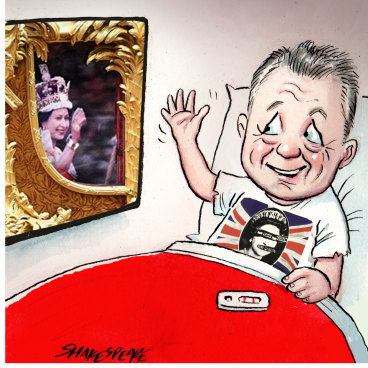Down Under Hundred years later in 2022 Matt Thistlethwaite composed the following message on Twitter: “Delighted to host meetings with representatives from the Australian Monarchist League and the Australian Republic Movement to discuss the Republic, royalty and referenda in our nation.”
Matt Thistlethwaite is defending more than the physical Australian shores
Rising from the Shadows: Republic
Low-ranking officials who held the line against Trump can teach us all a lesson
Let’s party 🎊 like it’s 1999 as republicans get a federal Labor boost
The man tasked with overseeing Australia’s shift to a republic says there are lessons to be learnt from the failed 1999 referendum.
Twenty-three years ago, Australians rejected the proposition that the nation become a republic with a president appointed by parliament.
Matt Thistlethwaite, the newly appointed Assistant Minister for the Republic, said he had been involved in that campaign and “division” among republicans on the best way to install a head of state was “fatal to its success”.
“I’m deeply conscious of that. And I want to avoid that in the future,” he told ABC Radio on Thursday.
Labor lays out plans for becoming a republic, with lessons from the 1999 referendum
Tracking the push for an Australian republic
Background Paper 9 1995-96 The Recent Republic Debate - A Chronology
Labor's plan for an Australian republic.
Australian Labor Party National ALP
Labor's plan for an Australian republic
Labor supports democracy, independence and equality. We believe we are big enough, talented enough, and strong enough to determine our own destiny and place in the world.
An ageing monarchy on the far side of the globe has little relevance to our country and our identity now.
Labor believes in an Australian Republic because the very nature of a hereditary monarch is contrary to our belief in equality, and built on privilege rather than effort or talent. We want Australia to step out into our region in its own right and we want any Australian to know they have an opportunity to hold the highest public office in
the land.
~ NIDA’s young artists might soon “stand as equal” and raise tough question such as “ Why is it that the US. can extradite Julian Assange from the UK to face charges but not Prince Andrew?”
Our great challenge now is to convince the community that a republic is not only good for our sense of identity, but also that it is worth changing our constitution.
Labor realises the push for a republic will not succeed if shaped by politicians, journalists and academics alone — it must be much broader.
Labor's new path to a republic will put all the key choices, at each stage, in the hands of the Australian people.
In the first 12 months of a Latham Labor Government we will hold a plebiscite to ask the simple question along the lines of — "do you want a republic with an Australian head of state?"
If the public say no, the debate is dead. If they say yes, we will hold a 2 nd plebiscite on the type of republic that Australians want — giving people options to choose from.
A plebiscite is a national, indicative vote. It is not binding but it is a way for the PM or the parliament to measure the community's view on any issue.
Having tested the water and found the republican model favoured by most Australians, Labor will then hold a referendum at the following federal election.
The beauty of this process is that every stage is in the hands of the public.
The path to an Australian republic is part of Labor's larger goal of reenergising Australia's civic institutions, and making Australian government more respected and more accessible.
Authorised by Tim Gartrell, 19 National Circuit, Barton ACT 2600.
Labor's plan for an Australian republic
Arguments against a plebiscite on an Australian republic
A reasonably detached observer could be forgiven for thinking that the Australian republican movement is floundering. The arguments against sharing a nominal head of state with another country, which is now a member of a foreign quasi-federation, seemed so irresistible. Why does the movement fall so far short of the degree of popular support required to carry the change?
Harry Evans "The Australian Head of State: Putting Republicanism into the Republic*" 1996 AD
A Note on the Meaning of 'Republic' - Parliament of Australia 1994 AD
The Pros And Cons Of Australia Being A Republic
Direct election republican model
As Buckingham Palace recently announced plans for an elaborate year of celebrations to mark the Queen’s Platinum Jubilee, a world away the Australian Republican Movement (ARM) launched a new proposed model for an Australian republic, desperately hoping to reignite the long-debated issue of Australia’s future.
And it appears to be a good and brave proposal.
Not everyone will be happy with ARM’s new model, but there are key changes that are worth looking at if we’re to move beyond the failed 1999 referendum that posed two questions:
The first significant change in the new model is that the ARM has endorsed the popular election process. This has been questioned by some critics, but it appears to be what the public wants, and we need to be realistic; this debate has no chance of progressing without the support of the voting public.
Importantly, the new model doesn’t prevent the possibility of a political election for head of state where the three major political parties might each endorse one or more candidates.
It does however, contemplate the possibility that this might not occur or that a political consensus might emerge on a single candidate as has happened in Ireland occasionally.
Some six out of 13 Irish presidential terms since 1938 have been by agreement on a single candidate, nullifying the need for a contested vote (though the ARM model suggests a vote should still take place in this scenario – which may be somewhat superfluous and even problematic were the vote to be negative).
Importantly, the term ‘head of state’ is proposed in the new model rather than ‘president’ or ‘governor-general’, and this also seems to be sensibly neutral.
One of the most significant improvements is the requirement of a simple majority of both houses to remove a problematic head of state for misbehaviour or incapacity.
In 1999, the ARM model endorsed the instant dismissal of the head of state by the prime minister without cause. This was understandably controversial, and frankly unacceptable to Australians. The new model counters this while still preserving the prime minister’s authority.
Similarly, the model ensures we never see a repeat of the 1975 Whitlam dismissal in making it clear that a head of state cannot dismiss a prime minister who retains the confidence of the lower house…
Australia’s future: The new republic model is a good move forward
ARM'S new model for republic not the people's choice
Charles tells Commonwealth leaders dropping Queen is ‘for each to decide’ Guardian


